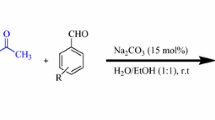Conclusions
-
1.
The reductive cyclization of polychloroalkanes of formula RCHClCH2CCl3 (R = H or C6H5) to form cyclopropane compounds is effected by treatment with zinc in ethanol.
-
2.
The formation of chlorinated cyclopropanones by cyclization of polychloroalkanes of the type RCCl2CH2CHClC6H5 (R=Cl or CH3) indicates that the mechanism of reductive cyclizations is the same for compounds with CCl2and CCl3 groups, starting with 1,3-dechlorination.
-
3.
The presence of a\(\begin{array}{*{20}c} \backslash \\ / \\ \end{array} CCl - CCl\begin{array}{*{20}c} / \\ \backslash \\ \end{array} \) fragment in the γ position to the CCl3 group hinders reductive cyclization.
Similar content being viewed by others
Literature cited
A. A. Kamyshova, S. D. Polishchuk, E. Ts. Chukovskaya, and R. Kh. Freidlina, Izv. Akad. Nauk SSSR, Ser. Khim., 185 (1977).
A. A. Kamyshova, E. Ts. Chukovskaya, and R. Kh. Freidlina, Dokl. Akad. Nauk SSSR, 233, 122 (1977).
R. Kh. Freidlina and E. Ts. Chukovskaya, Synthesis, 477 (1974).
J. A. Roth, J. Catal.,26, 97 (1972).
F. A. Bovey, NMR Data Tables for Organic Compounds, Wiley-Interscience, New York, Vol. 1, No. 1995, p. 278.
R. Kh. Freidlina, N. A. Kuz'mina, S. D. Polishchuk, and E. Ts. Chukovskaya, Izv. Akad. Nauk SSSR, Ser. Khim., 174 (1977).
V. L. Troyanker, A. A. Beer, and V. Ya. Katsobashvili, Zh. Org. Khim.,12, 1872 (1976).
T. Sato, M. Seno, and T. Asahara, Seisan Kenkyu, Mon. Inst. Ind. Sci. Univ. Tokyo,24, 230 (1972).
R. R. Kostikov, in: NMR in Organic Chemistry [in Russian], No. 3, Izd. Leningr. Univ. (1974), p. 20.
N. M. Kizhner, Zh. Russk. Fiz.-Khim. Obshch.,47, 1106 (1915).
K. B. Wiberg, D. E. Barth, and P. H. Schertler, J. Org. Chem.,38, 378 (1973).
W. L. Dilling, J. Org. Chem.,29, 960 (1964).
P. Weyerstahl, D. Klamann, C. Finger, F. Nerdel, and J. Buddrus, Ber.,100, 1858 (1967).
E. H. Huntress, Organic Chlorine Compounds, J. Wiley, Chapman and Hall (1948), p. 1063.
E. B. Whipple and G. R. Evanega, Org. Magn. Reson.,2, 1 (1970).
Author information
Authors and Affiliations
Additional information
Translated from Izvestiya Akademii Nauk SSSR, Seriya Khimicheskaya, No. 2, pp. 392–395, February, 1979.
The authors wish to thank L. D. Sychkova for supplying the sample of l-methyl-2-phenylcyclopropane.
Rights and permissions
About this article
Cite this article
Freidlina, R.K., Kamyshova, A.A., Posledova, N.N. et al. Synthesis of cylclopropanes by reductive cyclization of polychloroalkanes containing a CCl3 OR CCl2 group. Russ Chem Bull 28, 362–365 (1979). https://doi.org/10.1007/BF00925884
Received:
Issue Date:
DOI: https://doi.org/10.1007/BF00925884



